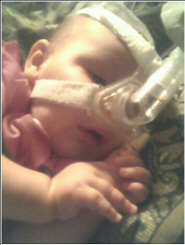|
Elizabeth's Machines!

|
In/Exsufflator:
other wise known as “the cough machine” or “cough assist”. It does
just what those terms imply...it assists Elizabeth in coughing
effectively. The machine blows 40cm of air into Elizabeth lungs and
sucks the same amount out. This enables us to clear her lungs, upper
airway and sinuses of any plugs or bothersome secretions. The “cough
machine” is also an excellent means of expanding the lungs to their
fullest, and exercising the muscles that surround them. |
|
The Bipap Machine:
this machine gives Elizabeth a deeper breath of air with every
breath she takes on her own. It also has a back-up rate, so
when Elizabeth is on it, she gets certain amount of breaths per
minute. Elizabeth uses her BiPap for nocturnal sleep and naps. She
also uses it as needed when ill. This machine, along with the one
that follows in this list, enabled us to keep Elizabeth at home
during her last severe illness. While the BiPap is at work, we
know that Elizabeth's lung muscles are being exercised...and that
she is also being given a rest, so that she is better able to
breathe efficiently on her own when she is off. (It looks much
worse than it is) It also gives Elizabeth more energy because she
does not have to work so hard while sleeping. |

The Hazards of Oxygen:
One of the most common
treatment errors for people with neuromuscular disorders is
oxygen therapy, which Bach likens to "putting a Band-Aid on
a cancer." He says that oxygen should never be used for
people with neuromuscular conditions unless pneumonia has
resulted in the need for intubation and intensive care.
Oxygen turns off the brain's drive to breathe and greatly
increases the likelihood of ventilatory failure, basically
allowing the blood's carbon dioxide to increase to levels
that render a person unconscious and cause him to stop
breathing entirely (respiratory arrest).
Usually decreases in blood oxygen levels are caused by
airway secretions that the patient is not strong enough to
clear without training in Bach's methods and the secretions
themselves can also result in respiratory arrest.
|
|
Pulse Oximeter: this device enables us
to monitor oxygen saturation levels (SATs), which is highly
important. If a child is unable to maintain certain oxygen
levels, it can be indicative of something that might be
brewing in the lungs, upper airway, etc. It is also an
excellent way to see how your child is doing moment to
moment...if BiPap might be needed for some extra air, etc.
The “pulse ox” also allows us to monitor heart rate. Heart
rate can also be indicative of something that might be going
on...such as discomfort if the heart rate is too high. |

|
The
Suction Machine: We use this because
Elizabeth is unable to swallow very well we use the
suction machine to suck out secretions from her mouth
and nose. This machine is a necessary piece of equipment
for Elizabeth and other SMA Type 1 kids. We also
use it during the cough asst . When Elizabeth coughs
with the cough asst it brings up secretions. We
take the suction machine where ever we go. It has a back
up battery that lasts 4 hours. |

|
IPV:
Intrapulmonary Percussive Ventilation (IPV). IPV
is a therapy that delivers moist mini bursts of
air into the lungs keeping the airways open and
loosen the mucus. This machine has kept
Elizabeth out of the hospital for over a year
now. It helps break up mucus plugs and also
helps clear Elizabeth's lungs during illnesses.
We use this machine at least once a day and when
she is ill 4 times a day. The machine has a
pressure manometer to show the amount of mini
burst or pressure that is generated inside the
lungs. The machine also contains a dial to
adjust the speed or percussion of the mini
bursts of air. The device uses a mouthpiece
attached to a nebulizer with a manifold. A
silver thumb switch, on the top of the
nebulizer, allows for self administration of the
mini bursts. Tubings to power the nebulizer and
manifold are color coded to their correct
connections for easy placement. The nebulizer is
filled to the 20cc line with a bronchodialator
and/or normal saline. |
|

|